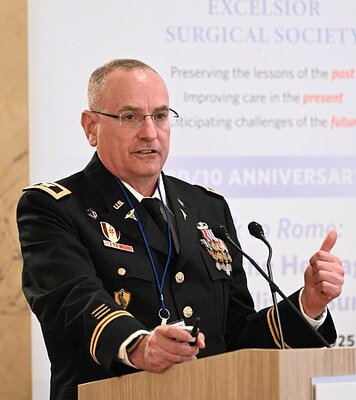
Bridging the Battlefield-to-ER Gap: Trauma Expert Urges Enhanced Civilian Preparedness
As geopolitical risks & domestic disasters rise, a leading trauma surgeon—with decades of military & civilian experience—calls for a unified approach to large-scale emergency response. Is the US truly ready?
Bridging the Battlefield-to-ER Gap: Trauma Expert Urges Enhanced Civilian Preparedness
Portland, Ore. – November 1, 2025 – As global instability and domestic disaster risks continue to escalate, a leading trauma surgeon is urging a fundamental shift in how the U.S. prepares for large-scale casualty events. Colonel (Ret.) Dr. Martin Schreiber, a veteran of both military combat hospitals and civilian trauma centers, will deliver a keynote address at the North Pacific Surgical Association (NPSA) annual meeting in Banff, Canada, on November 21st, challenging attendees to move beyond preparedness talks and embrace concrete action.
Dr. Schreiber’s address, titled “Are We Ready for Large Scale Combat Operations?”, isn't solely focused on military scenarios. He argues that the lessons learned on the battlefield – in hemorrhage control, rapid triage, and resource allocation under extreme pressure – are directly applicable, and vital, to strengthening civilian emergency response capabilities.
“The principles of trauma care don’t change whether you’re treating a soldier in Iraq or a victim of a mass shooting at home,” explains a source familiar with Dr. Schreiber’s work. “The difference often lies in the infrastructure, training, and coordination.”
From Baghdad to the Emergency Room: A Unique Perspective
Dr. Schreiber’s career spans over 35 years, marked by extensive deployments to Iraq and Afghanistan, where he provided critical care to both military personnel and local civilians. This experience has shaped his understanding of trauma care in resource-constrained environments, and the importance of adaptability and innovation. Following his time in active service, Dr. Schreiber became a Professor of Surgery at Oregon Health & Science University (OHSU) and led the Donald D. Trunkey Center for Civilian and Combat Casualty Care.
The Trunkey Center, established to bridge the gap between military and civilian trauma care, has become a hub for research, education, and policy advocacy. “Dr. Schreiber was instrumental in creating a culture of collaboration between military and civilian surgeons,” says a colleague. “He recognized that we all have something to learn from each other.”
The Growing Threat Landscape & Civilian Vulnerabilities
The need for enhanced preparedness is increasingly apparent. Recent events – from natural disasters like the 2023 Turkey-Syria earthquake to ongoing geopolitical conflicts – highlight the fragility of existing systems. Experts warn that the U.S. faces a growing number of potential threats, including terrorism, mass shootings, and increasingly frequent and severe climate-related disasters.
“We’re seeing a convergence of factors that are increasing the risk of mass casualty events,” explains a disaster preparedness analyst. “Our healthcare system is already strained, and it’s not adequately prepared to handle a large-scale event.”
One critical challenge is the lack of standardization in trauma care protocols across the country. While some states have robust trauma systems, others lack the necessary infrastructure and training. This creates disparities in care and can lead to preventable deaths.
Key Lessons from the Battlefield: Applying Military Expertise to Civilian Settings
Dr. Schreiber’s work emphasizes several key lessons from the battlefield that can be applied to civilian emergency response:
- Hemorrhage Control: Military surgeons have pioneered advanced techniques for controlling severe bleeding, such as tourniquet application and the use of hemostatic agents. These techniques are now becoming increasingly common in civilian trauma centers.
- Rapid Triage: In combat situations, surgeons must quickly assess the severity of injuries and prioritize treatment. This skill is crucial in mass casualty events, where resources are limited.
- Damage Control Surgery: This involves rapidly stabilizing patients with life-threatening injuries, even if it means leaving some injuries untreated until the patient is stabilized.
- Forward Surgical Teams: The military utilizes mobile surgical teams that can be deployed to remote locations. This concept is being adapted in some areas to provide emergency care to victims of natural disasters or mass shootings.
“The military has a long history of innovation in trauma care,” says a source familiar with Dr. Schreiber’s work. “They’ve been forced to develop solutions to challenges that most civilian surgeons never encounter.”
Moving Beyond Preparedness: The Call for Concrete Action
Dr. Schreiber’s keynote address at the NPSA meeting is expected to be a call to action. He is urging surgeons, healthcare administrators, and policymakers to move beyond preparedness exercises and invest in concrete improvements to the nation’s trauma care system. This includes:
- Standardizing Trauma Care Protocols: Developing national standards for trauma care to ensure that all patients receive the same high-quality care, regardless of their location.
- Investing in Trauma Training: Providing surgeons and other healthcare professionals with the training they need to manage complex trauma cases.
- Strengthening Trauma Systems: Investing in infrastructure, equipment, and personnel to improve the capacity of trauma centers to handle mass casualty events.
- Enhancing Coordination: Improving communication and coordination between hospitals, emergency medical services, and other agencies involved in emergency response.
“Talk is cheap,” emphasizes a colleague of Dr. Schreiber. “We need to translate these conversations into action. The lives of countless individuals depend on it.”
The NPSA meeting is expected to provide a platform for discussing these challenges and identifying potential solutions. Dr. Schreiber’s address is likely to be a catalyst for change, prompting a renewed focus on trauma preparedness and resilience.
